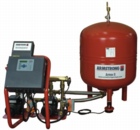Expansion and deaeration system operates at atmospheric pressure

Armstrong’s Armex II series of high-volume pressurisation and degassing systems enables the requirements of sealed heating and chilled water applications to be met with a much smaller and safer vessel. The space-saving benefits arise from the design of the tank, which accepts a greater volume for fluid expansion compared to traditional tanks.
They have a specially designed receptacle instead of a fixed air-cushion vessel. Armex II has acceptance levels approaching 90% and operates at atmospheric pressure, so it is exempt from the statutory health-and safety regimes. Make-up water is introduced as required.
The package is micro-processor controlled, so it can be used for a wide range of temperatures, pressures, transfer volumes and variations in code regulations and installation practices. System monitoring and diagnostics are available with a BMS interface or remote communication module.
The Armex II controllers also manages system deaeration. The controller passes adjustable volumes of water out of the pressurised circuits into the vessel on a timed basis to continually deaerate the system.







